Analysis of Wind Turbine Equipment Failure and Intelligent Operation and Maintenance Research
Abstract
1. Introduction
2. Main Components and Faults Analysis of Wind Turbines
2.1. Analysis of Main Components in Wind Turbine
- Blade
- Pitch System
- Gear box
- Yaw system
2.2. Analysis of Common Faults in Wind Turbines
- Failure of blade
- (a)
- Failure of fracture and cracking
- Design defects
- Leaf material quality does not meet requirements
- Change in production technology without authorization
- Inexperienced manufacturers
- (b)
- Damage caused by lightning strikes
- Cracks in the lightning conductor and blades
- Fouled blade surface
- (c)
- Local surface abrasion and cracking
- Abrasion by wind sand and water vapor
- High-speed wind, shear wind, bad weather, and fatigue life
- Failure of gearbox
- (a)
- Tooth surface corrosion
- (b)
- Tooth surface wear
- (c)
- Tooth surface gluing
- (d)
- Broken gear teeth
- Failure of pitch system
- (a)
- Pitch shaft cabinet battery under voltage
- (b)
- Abnormal hub detection data
- (c)
- Paddle angle deviation exceeds limit
- Failure of yaw system
- (a)
- Abnormal noise
- Yaw drive motor
- Yaw transmission
- Yaw big gear ring
- Yaw gear pair fit clearance
- Yaw bearing
- Yaw brake
- (b)
- Yaw drive machinery is stuck
- (c)
- Inaccurate yaw positioning
3. Cost Analysis of Intelligent Operation and Maintenance for Wind Energy
3.1. Analysis of Wind Power Intelligent Operation and Maintenance Cost Components
3.2. Analysis of Wind Power Intelligent Operation and Maintenance Cost Control
- Decision support system
- Fault warning and health management
- Life-Cycle Assessment
- Digital twin system
4. Research on Key Technologies for Intelligent Operation and Maintenance of Wind Turbines
4.1. Decision Support Systems
- Data acquisition
- Data processing
- Intelligent diagnosis
- Maintenance forecasting
4.2. Fault Diagnosis Models
4.3. Life-Cycle Costs
- Establishing a sound and universal whole life cost model requires in-depth research and discussion for different application scenarios. By quantifying the costs and benefits of wind farms at different stages, a reasonable optimization of the economic benefits of the whole wind farm can be achieved [205].
- It is necessary to strengthen data management and analysis capabilities by adopting efficient data mining and analysis algorithms, as well as more scientific, reasonable, and effective cost estimation methods; this will lead to fast and accurate data processing and will improve cost estimation capabilities.
- It is essential to establish an efficient, collaborative O&M mechanism; to strengthen the training and communication of O&M personnel; and to improve the cooperation between O&M teams, so as to achieve more efficient intelligent O&M for wind power.
5. Summary and Conclusions
- (a)
- Fault analysis and research of wind turbine
- Failure data comes from different platforms and systems, and the differences in data quality lead to certain problems in data stability and reliability. Data quality should be improved by methods such as standardizing defective data and creating a defect database to provide a basis for subsequent data analysis.
- Not only do wind turbines have a large number of installations and complex operational data, but the number of effective analyses for fault samples is small, which results in a lack of real and valid fault analysis data. By establishing a multi-domain fault data platform and providing more fault samples to accelerate the training efficiency of these machine learning algorithms, the accuracy of fault analysis results can be improved.
- The current fault analysis algorithms are based mainly on machine learning algorithms. However, while they have high accuracy, some of the algorithms have low processing efficiency, and it is difficult to address large-scale fault analysis problems. In order to develop more efficient and faster Java application systems for fault analysis decision support, new types of algorithms, such as deep-learning-based algorithms, should be actively practiced and developed.
- Fault diagnosis requires a large amount of domain knowledge and experience. However, in the actual fault analysis process, the analysis of the real situation is sometimes limited by the accumulation of knowledge. A fine-tuned fault knowledge system and modeling method should be established to correlate the wind turbine operational state with the fault mode to achieve accurate and fast fault diagnosis and evaluation.
- (b)
- Research on key technologies of wind energy intelligent O&M
- Wind turbines produce a variety of data during operation, and the data are numerous, scattered, and discontinuous; thus, a refined data acquisition system must be established to integrate the data into an analyzable format. A fast and efficient data acquisition system should be established to integrate discrete and scattered data into an analyzable format to provide a basis for wind turbine condition monitoring and prediction.
- Data analysis algorithms and models suitable for wind turbines need to be established, and based on these algorithms and models, intelligent diagnosis and early warning systems need to be developed to diagnose and prevent wind turbine failures in a timely and accurate manner.
- A large amount of data and analysis results must be accurately and reliably transformed into effective decision support to realize automated operation and intelligent decision making. A reliable and practical intelligent decision support system should be established to deeply analyze the meaning behind the data and to provide intelligent decision support.
- The intelligent O&M system undoubtedly faces hidden security problems, such as system attacks and data leakage, which seriously affect the safe and stable operation of wind turbines. Strict measures such as data encryption, system security prevention, and vulnerability repair should be taken to improve the security and confidentiality of the wind power intelligent O&M system.
Author Contributions
Funding
Institutional Review Board Statement
Informed Consent Statement
Data Availability Statement
Acknowledgments
Conflicts of Interest
References
- Wang, Q.; Gao, Z.; Yuan, X.; Wang, J.; Wang, M. Comprehensive energy evaluation and optimization of corn straw power generation system: A case study. Chin. J. Popul. Resour. 2019, 17, 135–144. [Google Scholar]
- Ramadan, S.; Abdelrahman, A.; Sharaf, M. Wind potential investigation with turbine siting control for improved energy yield at El-Tor Region, Egypt. Comput. Electr. Eng. 2022, 100, 853–863. [Google Scholar] [CrossRef]
- Gao, C.; Chen, H.; Xie, Y.; Qi, L. Conceptual Design and Motion Response Research of Wind Power Operation and Maintenance Life Platform. J. Res. Sci. Eng. 2020, 2, 132484. [Google Scholar]
- Chen, H.; Xi, S. Cost composition and price mechanism of offshore wind power. Wind Eng. 2022, 1, 12–15. [Google Scholar]
- Wang, Z.; Guo, Y.; Wang, H. Review on Monitoring and Operation-Maintenance Technology of Far-Reaching Sea Smart Wind Farms. J. Mar. Sci. Eng. 2022, 10, 820. [Google Scholar] [CrossRef]
- Pang, B.; Tian, T.; Tang, G. Fault state recognition of wind turbine gearbox based on generalized multi-scale dynamic time warping. Struct. Health Monit. 2021, 20, 2013–2024. [Google Scholar] [CrossRef]
- Main Components of a Horizontal Axis Wind Turbine. Available online: https://www.researchgate.net/figure/5-Main-components-of-a-horizontal-axis-wind-turbine_fig3_235340138 (accessed on 6 January 2010).
- Chen, C.S. Study on the Daily Maintenance and Fault Handling of Wind Turbine. Parabol. Equ. Mat. 2021, 50, 34–36. Available online: https://kns.cnki.net/kcms2/article/abstract?v=3uoqIhG8C44YLTlOAiTRKibYlV5Vjs7iJTKGjg9uTdeTsOI_ra5_Xaw0AwD42Ay9RBfe6ugmAmgSOS7MhgW-i3aoCH0XzA-T&uniplatform=NZKPT (accessed on 2 April 2022).
- Li, H.; Wang, X.; Wang, D. Study on fault diagnosis of wind turbine pitch system based on fault tree. Plant Maint. Eng. 2022, 15, 168–169. [Google Scholar] [CrossRef]
- Wang, X.M. Analysis of high speed shaft tooth break in wind turbine gearbox. Electr. Eng. 2022, 4, 58–60. [Google Scholar] [CrossRef]
- Sanjeev, K.; Vikash, K.; Somnath, S.; Prakash, S.O. Gearbox fault diagnosis: A higher order moments approach. Measurement 2023, 210, 112489. [Google Scholar]
- Solomin, E.V.; Ryavkin, G.N. Horizontal Axis Wind Turbine Weather Vane Aerodynamic Characteristics: Delayed Detached Eddy Simulation and Experimental Approach. Mathematics 2023, 11, 1834. [Google Scholar] [CrossRef]
- Liu, Y.N. Analysis of Abnormal Sound and Vibration of Wind Turbine Yaw System. Encycl. Forms 2020, 9, 1651. Available online: https://d.wanfangdata.com.cn/periodical/ChlQZXJpb2RpY2FsQ0hJTmV3UzIwMjMwMzIxEhJia2x0ZHp6ejIwMjAwOTMyNzQaCGhzNDFxdzMx (accessed on 13 November 2020).
- Jard, T.; Snaiki, R. Real-Time Repositioning of Floating Wind Turbines Using Model Predictive Control for Position and Power Regulation. Wind 2023, 3, 131–150. [Google Scholar] [CrossRef]
- Zhang, P.; Lu, D. A Survey of Condition Monitoring and Fault Diagnosis towards Integrated O&M for Wind Turbines. Energies 2019, 12, 2801. [Google Scholar]
- Quaranta, E.; Davies, P. Emerging and innovative materials for hydropower engineering applications: Turbines, bearings, sealing, dams and waterways, and ocean power. Engineering 2021, 8, 148–158. [Google Scholar] [CrossRef]
- Hu, A.; Xiang, L.; Zhu, L. An engineering condition indicator for condition monitoring of wind turbine bearings. Wind Eng. 2020, 23, 207–219. [Google Scholar] [CrossRef]
- Wang, J.; Liang, Y.; Zheng, Y.; Gao, R.X.; Zhang, F. Study on the design principle of the new wind turbine transmission scheme. Renew. Energy 2018, 36, 593–597. [Google Scholar]
- Zhang, J.; Zhang, M.; Li, Y.; Qin, J.; Wei, K.; Song, L. Analysis of wind characteristics and wind energy potential in complex mountainous region in southwest China. J. Clean. Prod. 2020, 274, 123036. [Google Scholar] [CrossRef]
- Wang, Y.; Zhu, C.; Li, Y.; Tan, J. Maximizing the total power generation of faulty wind turbines via reduced power operation. Energy Sustain. Dev. 2021, 65, 36–44. [Google Scholar] [CrossRef]
- Song, X.; Xing, Z.; Jia, Y.; Song, X.; Cai, C.; Zhang, Y.; Wang, Z.; Guo, J.; Li, Q. Review on the Damage and Fault Diagnosis of Wind Turbine Blades in the Germination Stage. Energies 2022, 15, 7492. [Google Scholar] [CrossRef]
- Okulov, V.; Kabardin, I.; Mukhin, D.; Stepanov, K.; Okulova, N. Physical De-Icing Techniques for Wind Turbine Blades. Energies 2021, 14, 6750. [Google Scholar] [CrossRef]
- Jiménez, A.A.; Zhang, L.; Muñoz, C.Q.G.; Márquez, F.P.G. Maintenance management based on machine learning and nonlinear features in wind turbines. Renew. Energy 2020, 146, 316–328. [Google Scholar] [CrossRef]
- A 3MW E-115 Unit of Enercon Suffered a Blade Fracture Accident due to Over-Speed Wind Turbine. Available online: http://www.cweea.com.cn/xwdt/html/13122.html (accessed on 15 March 2018).
- Barbosa, N.B.; Nunes, D.D.G.; Santos, A.Á.B.; Machado, B.A.S. Technological Advances on Fault Diagnosis in Wind Turbines: A Patent Analysis. Appl. Sci. 2023, 13, 1721. [Google Scholar] [CrossRef]
- Chou, J.S.; Ou, Y.C.; Lin, K.Y. Collapse mechanism and risk management of wind turbine tower in strong wind. J. Wind. Eng. Ind. Aerodyn. 2019, 193, 103962. [Google Scholar] [CrossRef]
- Stetco, A.; Dinmohammadi, F.; Zhao, X.; Robu, V.; Flynn, D.; Barnes, M.; Keane, J.; Nenadic, G. Machine learning methods for wind turbine condition monitoring: A review. Renew. Energy 2019, 133, 620–635. [Google Scholar] [CrossRef]
- Zhang, M.; Zhang, J.; Li, Y.; Yu, J.; Qin, J.; Wei, K.; Song, L. Multi-site measurement for energy application of small distributed wind farm in complex mountainous areas. Energy Rep. 2020, 6, 1043–1056. [Google Scholar] [CrossRef]
- Steffen, B.; Beuse, M.; Tautorat, P.; Schmidt, T.S. Experience curves for operations and maintenance costs of Renewable Energy technologies. Joule 2020, 4, 359–375. [Google Scholar] [CrossRef]
- In the Age of Industrial Intelligence, How Intelligent Can the Fan Blade Be? Available online: https://www.163.com/dy/article/ESJG5GKS05509P99.html (accessed on 28 October 2019).
- Igba, J.; Alemzadeh, K.; Durugbo, C.; Eiriksson, E.T. Technology, Through-life engineering services of wind turbines. CIRP J. Manuf. Sci. Technol. 2017, 17, 60–70. [Google Scholar] [CrossRef]
- Koitz, R.; Wotawa, F.; Lüftenegger, J.; Gray, C.S.; Langmayr, F. Wind Turbine Fault Localization: A Practical Application of Model-Based Diagnosis. In Diagnosability, Security and Safety of Hybrid Dynamic and Cyber-Physical Systems; Springer: Berlin/Heidelberg, Germany, 2018; pp. 17–43. [Google Scholar]
- Gao, Z.; Liu, X. An Overview on Fault Diagnosis, Prognosis and Resilient Control for Wind Turbine Systems. Processes 2021, 9, 300. [Google Scholar] [CrossRef]
- A Detailed Corrosion Prevention Program for the Wind Power Industry. Available online: https://www.sohu.com/a/485092258_100302556 (accessed on 23 August 2021).
- Jimenez-Martinez, M.J.H. Harbor and coastal structures: A review of mechanical fatigue under random wave loading. Heliyon 2021, 7, e08241. [Google Scholar] [CrossRef]
- Schwack, F.; Stammler, M.; Flory, H.; Poll, G. Free contact angles in pitch bearings and their impact on contact and stress conditions. In Proceedings of the 2016 Wind Europe Conference, Hamburg, Germany, 27–29 September 2016; pp. 1–10. [Google Scholar]
- Bhardwaj, U.; Teixeira, A.P.; Soares, C.G. Reliability prediction of an offshore wind turbine gearbox. Renew. Energy 2019, 141, 693–706. [Google Scholar] [CrossRef]
- Lin, Z.; Cevasco, D.; Collu, M. A methodology to develop reduced-order models to support the operation and maintenance of offshore wind turbines. Appl. Energy 2020, 259, 114228. [Google Scholar] [CrossRef]
- Yan, X.; She, D.; Xu, Y.; Jia, M. Application of Generalized Composite Multiscale Lempel–Ziv Complexity in Identifying Wind Turbine Gearbox Faults. Entropy 2021, 23, 1372. [Google Scholar] [CrossRef]
- Application of Industrial Endoscope in the Detection of Wind Turbine Gearbox. Available online: https://www.chem17.com/tech_news/detail/2198984.html (accessed on 29 April 2020).
- Rabaia, M.K.H.; Abdelkareem, M.A.; Sayed, E.T.; Elsaid, K.; Chae, K.-J.; Wilberforce, T.; Olabi, A. Environmental impacts of solar energy systems: A review. Sci. Total Environ. 2021, 754, 141989. [Google Scholar] [CrossRef]
- Liu, Z.Q.; Sun, J.; Shen, W.D. Study of plowing and friction at the surfaces of plastic deformed metals. Tribol. Int. 2002, 35, 511–522. [Google Scholar] [CrossRef]
- Shot Peening Combined with Finishing to Repair Tooth Surface Failure. Available online: https://www.sohu.com/a/432754392_766672 (accessed on 18 November 2020).
- Bauer, A.; Menrad, K. Standing up for the Paris Agreement: Do global climate targets influence individuals’ greenhouse gas emissions? Environ. Sci. Policy 2019, 99, 72–79. [Google Scholar] [CrossRef]
- Przystupa, K. Research on the Durability and Reliability of Industrial Layered Coatings on Metal Substrate due to Abrasive Wear. Materials 2023, 16, 1779. [Google Scholar] [CrossRef]
- Several Failure Modes of Wind Power Gear. Available online: http://www.md-c.net/news_x-3470-1.html (accessed on 21 August 2018).
- Wind Power Gearbox Shaft Wear How to Repair? Available online: http://news.sohu.com/a/442770103_120342063 (accessed on 6 January 2021).
- Wei, J.; Niu, R.; Dong, Q.; Zhang, S. Fretting-slipping fatigue failure mode in planetary gear system. Int. J. Fatigue 2020, 136, 105632. [Google Scholar] [CrossRef]
- Ren, G.G. Hypo-elastohydrodynamic lubrication of journal bearings with deformable surface. Tribol. Int. 2022, 175, 107787. [Google Scholar] [CrossRef]
- Ren, J.; Yuan, H. A Dynamic Wear Prediction Model for Studying the Interactions between Surface Wear and Dynamic Response of Spur Gears. Coatings 2022, 12, 1250. [Google Scholar] [CrossRef]
- At Timken, Customer-Centric Innovation Drives Real-World Results. Available online: https://www.timken.com/ (accessed on 13 November 2018).
- Damage Problems of Gear and Bearing, Key Components of Wind Turbine Gearbox. Available online: https://www.sohu.com/a/275027446_99953492 (accessed on 13 November 2018).
- Luz, T.; Moura, P. 100% Renew. Energy planning with complementarity and flexibility based on a multi-objective assessment. Appl. Energy 2019, 255, 113819. [Google Scholar] [CrossRef]
- Gong, Y.; Fei, J.L.; Tang, J.; Yang, Z.G.; Han, Y.M.; Li, X. Failure analysis on abnormal wear of roller bearings in gearbox for wind turbine. Eng. Fail. Anal. 2017, 82, 26–38. [Google Scholar] [CrossRef]
- Greco, A.; Sheng, S.; Keller, J.; Erdemir, A. Material wear and fatigue in wind turbine systems. Wear 2013, 302, 1583–1591. [Google Scholar] [CrossRef]
- Godwin, J.L.; Matthews, P. Classification and Detection of Wind Turbine Pitch Faults through SCADA Data Analysis. Int. J. Progn. Health Manag. 2013, 4, 90–100. [Google Scholar] [CrossRef]
- Castellani, F.; Astolfi, D.; Natili, F. SCADA Data Analysis Methods for Diagnosis of Electrical Faults to Wind Turbine Generators. Appl. Sci. 2021, 11, 3307. [Google Scholar] [CrossRef]
- Li, M.; Wang, S.X. Dynamic Fault Monitoring of Pitch System in Wind Turbines using Selective Ensemble Small-World Neural Networks. Energies 2019, 12, 3256. [Google Scholar] [CrossRef]
- Yiran, S.; Shoutao, L.; Shuangxin, W. Pitch angle control with fault diagnosis and tolerance for wind turbine generation systems. Proc. Inst. Mech. Eng. 2021, 235, 1355–1366. [Google Scholar]
- Wang, H.; Wang, H.B.; Jiang, G.Q.; Wang, Y.L.; Ren, S.A. Multiscale Spatio-Temporal Convolutional Deep Belief Network for Sensor Fault Detection of Wind Turbine. Sensors 2020, 20, 3580. [Google Scholar] [CrossRef]
- Pan, J.H.; Qu, L.L.; Peng, K.X. Sensor and Actuator Fault Diagnosis for Robot Joint Based on Deep CNN. Entropy 2021, 23, 751. [Google Scholar] [CrossRef]
- Fezai, R.; Dhibi, K.; Mansouri, M.; Trabelsi, M.; Hajji, M.; Bouzrara, K.; Nounou, H.; Nounou, M. Effective Random Forest-Based Fault Detection and Diagnosis for Wind Energy Conversion Systems. IEEE Sens. J. 2021, 21, 6914–6921. [Google Scholar] [CrossRef]
- Lopez-Guede, J.M.; Ramos-Hernanz, J.A.; Zulueta, E.; Fernandez-Gamiz, U.; Oterino, F. Systematic modeling of photovoltaic modules based on artificial neural networks. Int. J. Hydrogen Energy 2016, 41, 12672–12687. [Google Scholar] [CrossRef]
- Lopez-Guede, J.M.; Ramos-Hernanz, J.A.; Zulueta, E.; Fernandez-Gamiz, U.; Azkune, G. Dual model oriented modeling of monocrystalline PV modules based on artificial neuronal networks. Int. J. Hydrogen Energy 2017, 42, 18103–18120. [Google Scholar] [CrossRef]
- Merabet, A.; Eshaft, H.; Tanvir, A.A. Power-current controller based sliding mode control for DFIG-wind energy conversion system. IET Renew. Power Gener. 2018, 12, 1155–1163. [Google Scholar] [CrossRef]
- Gonzalez-Gonzalez, A.; Etxeberria-Agiriano, I.; Zulueta, E.; Oterino-Echavarri, F.; Lopez-Guede, J.M. Pitch Based Wind Turbine Intelligent Speed Setpoint Adjustment Algorithms. Energies 2014, 7, 3793–3809. [Google Scholar] [CrossRef]
- Fernandez-Gauna, B.; Fernandez-Gamiz, U.; Grana, M. Variable speed wind turbine controller adaptation by reinforcement learning. Integr. Comput. Aided Eng. 2017, 24, 27–39. [Google Scholar] [CrossRef]
- Dai, J.; Yang, X.; Yang, W.; Gao, G.; Li, M. Further Study on the Effects of Wind Turbine Yaw Operation for Aiding Active Wake Management. Appl. Sci. 2020, 10, 1978. [Google Scholar] [CrossRef]
- Astolfi, D.; Castellani, F.; Terzi, L. Wind Turbine Power Curve Upgrades. Energies 2018, 11, 1300. [Google Scholar] [CrossRef]
- Terzi, L.; Lombardi, A.; Castellani, F.; Astolfi, D. Innovative methods for wind turbine power curve upgrade assessment. J. Phys. Conf. Ser. 2018, 1102, 012036. [Google Scholar] [CrossRef]
- Song, D.; Fan, X.; Yang, J.; Liu, A.; Chen, S.; Joo, Y.H. Power extraction efficiency optimization of horizontal-axis wind turbines through optimizing control parameters of yaw control systems using an intelligent method. Appl. Energy 2018, 224, 267–279. [Google Scholar] [CrossRef]
- Karakasis, N.; Mesemanolis, A.; Nalmpantis, T.; Mademlis, C. Active yaw control in a horizontal axis wind system without requiring wind direction measurement. IET Renew. Power Gener. 2016, 10, 1441–1449. [Google Scholar] [CrossRef]
- Shariatpanah, H.; Fadaeinedjad, R.; Rashidinejad, M. A New Model for PMSG-Based Wind Turbine with Yaw Control. IEEE Trans. Energy Convers. 2013, 28, 929–937. [Google Scholar] [CrossRef]
- Bartl, J.; Mühle, F.; Schottler, J.; Sætran, L.; Peinke, J.; Adaramola, M.; Hölling, M. Wind tunnel experiments on wind turbine wakes in yaw: Effects of inflow turbulence and shear. Wind Energy Sci. 2018, 3, 329–343. [Google Scholar] [CrossRef]
- Schottler, J.; Bartl, J.; Muhle, F.; Saetran, L.; Peinke, J.; Hoelling, M. Wind tunnel experiments on wind turbine wakes in yaw: Redefining the wake width. Wind Energy Sci. 2018, 3, 257–273. [Google Scholar] [CrossRef]
- Bartl, J.; Muhle, F.; Saetran, L. Wind tunnel study on power output and yaw moments for two yaw-controlled model wind turbines. Wind Energy Sci. 2018, 3, 489–502. [Google Scholar] [CrossRef]
- Urban, A.M.; Larsen, T.J.; Larsen, G.C.; Held, D.P.; Dellwik, E.; Verelst, D. Optimal yaw strategy for optimized power and load in various wake situations. J. Phys. Conf. Ser. 2018, 1102, 012019. [Google Scholar] [CrossRef]
- Annoni, J.; Bay, C.; Taylor, T.; Pao, L.; Fleming, P.; Johnson, K. Efficient Optimization of Large Wind Farms for Real-time Control. In Proceedings of the 2018 Annual American Control Conference(ACC), Milwaukee, WI, USA, 27–29 June 2018; pp. 6200–6205. [Google Scholar]
- Munters, W.; Meyers, J. Dynamic Strategies for Yaw and Induction Control of Wind Farms Based on Large-Eddy Simulation and Optimization. Energies 2018, 11, 177. [Google Scholar] [CrossRef]
- Damiani, R.; Dana, S.; Annoni, J.; Fleming, P.; Roadman, J.; Dam, J.V.; Dykes, K. Assessment of wind turbine component loads under yaw-offset conditions. Wind Energy Sci. 2018, 3, 173–189. [Google Scholar] [CrossRef]
- Song, D.; Yang, J.; Fan, X.; Liu, Y.; Liu, A.; Chen, G.; Joo, Y.H. Maximum power extraction for wind turbines through a novel yaw control solution using predicted wind directions. Energy Convers. Manag. 2018, 157, 587–599. [Google Scholar] [CrossRef]
- Fernandez-Gamiz, U.; Zulueta, E.; Boyano, A.; Ansoategui, I.; Uriarte, I. Five Megawatt Wind Turbine Power Output Improvements by Passive Flow Control Devices. Energies 2017, 10, 742. [Google Scholar] [CrossRef]
- Saenz-Aguirre, A.; Zulueta, E.; Fernandez-Gamiz, U.; Lozano, J.; Lopez-Guede, J.M. Artificial Neural Network Based Reinforcement Learning for Wind Turbine Yaw Control. Energies 2019, 12, 436. [Google Scholar] [CrossRef]
- Astolfi, D.; Castellani, F.; Natili, F. Wind Turbine Yaw Control Optimization and Its Impact on Performance. Machines 2019, 7, 41. [Google Scholar] [CrossRef]
- Ring Fracture due to Fatigue. Available online: https://www.sohu.com/a/489553951_121123705 (accessed on 13 September 2021).
- Fault Analysis and Solution for Yaw System of Hua-Chuang 1. 5MW Wind Turbine in a Wind Farm. Available online: http://www.chinaqking.com/yc/2021/3198508.html (accessed on 11 August 2021).
- Obane, H. Forecasting photovoltaic and wind energy capital costs in Japan: A Bayesian approach. Energy Procedia 2019, 158, 3576–3582. [Google Scholar] [CrossRef]
- Aguilar, S.; Telles, G.R.; Medina, P.; Quaresma, B.; Cyrino, F.L.; Castro, R. Wind power generation: A review and a research agenda. J. Clean. Prod. 2019, 218, 850–870. [Google Scholar]
- Li, H.Z.; Jing, T.; Zhang, H. Arena-based modeling of the maintenance operation for a wind farm. Appl. Mech. Mater. 2013, 3, 2205–2208. [Google Scholar] [CrossRef]
- Li, D.; Feng, Y.; Liu, Z.; Chu, J.; Jin, Q. Reliability modeling and maintenance strategy optimization for wind power generation sets. Power Syst. Technol. 2011, 35, 122–127. [Google Scholar]
- Hameed, Z.; Vatn, J.; Heggset, J. Challenges in the reliability and maintainability data collection for offshore wind turbines. Renew. Energy 2011, 36, 2154–2165. [Google Scholar] [CrossRef]
- Tavner, P.J.; Greenwood, D.M.; Whittle, M.W.G.; Gindele, R.; Faulstich, S.; Hahn, B. Study of weather and location effects on wind turbine failure rates. Wind Energy 2013, 16, 175–187. [Google Scholar] [CrossRef]
- Guo, P.; Infield, D.; Yang, X. Wind turbine gearbox condition monitoring using temperature trend analysis. IEEE Trans. Sustain. Energy 2012, 3, 124–133. [Google Scholar] [CrossRef]
- Carroll, J.; McDonald, A.; Dinwoodie, I.; McMillan, D.; Revie, M.; Lazakis, I. Availability, O & M Costs of Offshore Wind Turbines with Different Drive Train Configurations. Wind Energy 2017, 20, 361–378. [Google Scholar]
- Pandit, R.K.; Astolfi, D.; Cardenas, I.D. A Review of Predictive Techniques Used to Support Decision Making for Maintenance Operations of Wind Turbines. Energies 2023, 16, 1654. [Google Scholar] [CrossRef]
- Sunila, K.; Bergaentzlé, C.; Martin, B.; Ekroos, A. A supra-national TSO to enhance offshore wind power development in the Baltic Sea? A legal and regulatory analysis. Energy Policy 2019, 128, 775–782. [Google Scholar] [CrossRef]
- Wu, X.; Hu, Y.; Li, Y.; Yang, J.; Duan, L.; Wang, T.; Adcock, T.; Jiang, Z.; Gao, Z.; Lin, Z. Foundations of Offshore Wind Turbines: A Review. Renew. Sustain. Energy Rev. 2019, 104, 379–393. [Google Scholar] [CrossRef]
- Shadman, M.; Amiri, M.M.; Silva, C.; Estefen, S.F.; La Rovere, E. Environmental impacts of offshore wind installation, O & M, and decommissioning activities: A case study of Brazil. Renew. Sustain. Energy Rev. 2021, 144, 110994. [Google Scholar]
- Ng, E.Y.-K.; Lim, J.T. Machine Learning on Fault Diagnosis in Wind Turbines. Fluids 2022, 7, 371. [Google Scholar] [CrossRef]
- Fan, Q.; Wang, X.; Yuan, J.; Liu, X.; Hu, H.; Lin, P. A Review of the Development of Key Technologies for Offshore Wind Power in China. J. Mar. Sci. Eng. 2022, 10, 929. [Google Scholar] [CrossRef]
- Khajah, A.M.H.A.; Philbin, S.P. Techno-Economic Analysis and Modelling of the Feasibility of Wind Energy in Kuwait. Clean Technol. 2022, 4, 14–34. [Google Scholar] [CrossRef]
- Santolamazza, A.; Dadi, D.; Introna, V. A Data-Mining Approach for Wind Turbine Fault Detection Based on SCADA Data Analysis Using Artificial Neural Networks. Energies 2021, 14, 1845. [Google Scholar] [CrossRef]
- Akhter, M.Z.; Omar, F.K. Review of Flow-Control Devices for Wind-Turbine Performance Enhancement. Energies 2021, 14, 1268. [Google Scholar] [CrossRef]
- McKinnon, C.; Turnbull, A.; Koukoura, S.; Carroll, J.; McDonald, A. Effect of Time History on Normal Behaviour Modelling Using SCADA Data to Predict Wind Turbine Failures. Energies 2020, 13, 4745. [Google Scholar] [CrossRef]
- Maldonado-Correa, J.; Martín-Martínez, S.; Artigao, E.; Gómez-Lázaro, E. Using SCADA Data for Wind Turbine Condition Monitoring: A Systematic Literature Review. Energies 2020, 13, 3132. [Google Scholar] [CrossRef]
- Herp, J.; Pedersen, N.L.; Nadimi, E.S. Assessment of Early Stopping through Statistical Health Prognostic Models for Empirical RUL Estimation in Wind Turbine Main Bearing Failure Monitoring. Energies 2020, 13, 83. [Google Scholar] [CrossRef]
- Zhang, H.L.; Shang, M.X.; Liu, Z.L.; Liu, Y.; Yang, N. Key Equipment and Technology for Offshore Wind Power Maintenance. Ship Eng. 2021, 43, 6–8. [Google Scholar]
- Mitchell, D.; Blanche, J.; Harper, S.; Lim, T.; Gupta, R.; Zaki, O.; Tang, W.; Robu, V.; Watson, S.; Flynn, D. A review: Challenges and opportunities for artificial intelligence and robotics in the offshore wind sector. Energy AI 2022, 8, 100146. [Google Scholar] [CrossRef]
- Moghadam, F.K.; Nejad, A.R. Online condition monitoring of floating wind turbines drivetrain by means of digital twin. Mech. Syst. Signal Process. 2022, 162, 108087. [Google Scholar] [CrossRef]
- Zeng, J.P.; Guo, J.X.; Jiang, G.D.; Huang, X.; Hong, X.; Lian, B. Traffic safety supervision scheme of offshore wind farms based on three-dimensional perception technique. J. Shanghai Inst. Shipbuild. Transp. Sci. 2020, 43, 61–64. [Google Scholar]
- Florian, M.; Sørensen, J.D. Risk-Based Planning of Operation and Maintenance for Offshore Wind Farms. Energy Procedia 2017, 137, 261–272. [Google Scholar] [CrossRef]
- Song, T.X.; Zhang, T.; Zhang, Y.M.; Huang, B.Q. Technology of operation and maintenance management for offshore wind farm based on lean MRO thinking. Comput. Integr. Manuf. Syst. 2017, 23, 387–395. [Google Scholar]
- Liu, R.; Solangi, Y.A. An Analysis of Renewable Energy Sources for Developing a Sustainable and Low-Carbon Hydrogen Economy in China. Processes 2023, 11, 1225. [Google Scholar] [CrossRef]
- Empig, E.E.; Sivacioğlu, A.; Pacaldo, R.S.; Suson, P.D.; Lavilles, R.Q.; Teves, M.R.Y.; Ferolin, M.C.M.; Amparado, R.F., Jr. Climate Change, Sustainable Forest Management, ICT Nexus, and the SDG 2030: A Systems Thinking Approach. Sustainability 2023, 15, 6712. [Google Scholar] [CrossRef]
- Stamate, M.-A.; Pupăză, C.; Nicolescu, F.-A.; Moldoveanu, C.-E. Improvement of Hexacopter UAVs Attitude Parameters Employing Control and Decision Support Systems. Sensors 2023, 23, 1446. [Google Scholar] [CrossRef]
- Li, J.; Wang, S.; Yang, J.; Zhang, H.; Zhao, H. A Digital Twin-Based State Monitoring Method of Gear Test Bench. Appl. Sci. 2023, 13, 3291. [Google Scholar] [CrossRef]
- Xiong, J.; Ye, H.; Pei, W.; Kong, L.; Huo, Q.; Han, Y. A monitoring and diagnostics method based on FPGA-digital twin for power electronic transformer. Electr. Power Syst. Res. 2022, 210, 108111. [Google Scholar] [CrossRef]
- Hou, G.; Xu, K.; Lian, J. A review on recent risk assessment methodologies of offshore wind turbine foundations. Ocean. Eng. 2022, 264, 112469. [Google Scholar] [CrossRef]
- Shen, L. Analysis of risk management and control in the construction of large-scale wind power projects. Eng. Constr. Des. 2022, 23, 239–241. [Google Scholar]
- Zhao, S.; Su, X.; Li, J.; Suo, G.; Meng, X. Research on Wind Power Project Risk Management Based on Structural Equation and Catastrophe Theory. Sustainability 2023, 15, 6622. [Google Scholar] [CrossRef]
- El Bazi, N.; Mabrouki, M.; Laayati, O.; Ouhabi, N.; El Hadraoui, H.; Hammouch, F.-E.; Chebak, A. Generic Multi-Layered Digital-Twin-Framework-Enabled Asset Lifecycle Management for the Sustainable Mining Industry. Sustainability 2023, 15, 3470. [Google Scholar] [CrossRef]
- Wang, Y.; Sun, W.; Liu, L.; Wang, B.; Bao, S.; Jiang, R. Fault Diagnosis of Wind Turbine Planetary Gear Based on a Digital Twin. Appl. Sci. 2023, 13, 4776. [Google Scholar] [CrossRef]
- World Wind Energy Association (WWEA). Half-Year Report 2014; World Wind Energy Association: Bonn, Germany, 2014. [Google Scholar]
- European Wind Energy Association (EWEA). Wind in Power 2015 European Statistics; Technical Report; World Wind Energy Association: Bonn, Germany, 2016. [Google Scholar]
- Wind Europe. The European Offshore Wind Industry-Key Trends and Statistics 2016; Technical Report; Wind Europe: Brussels, Belgium, 2017. [Google Scholar]
- Feng, Y.; Tavner, P.; Long, H. Early experiences with UK round 1 offshore wind farms. Proc. Inst. Civ. Eng. 2010, 163, 167–181. [Google Scholar] [CrossRef]
- Gintautas, T.; Sørensen, J.D. Improved Methodology of Weather Window Prediction for Offshore Operations Based on Probabilities of Operation Failure. J. Mar. Sci. Eng. 2017, 5, 20. [Google Scholar] [CrossRef]
- Seyr, H.; Muskulus, M. Using a Langevin model for the simulation of environmental conditions in an offshore wind farm. J. Phys. Conf. Ser. 2018, 1104, 012023. [Google Scholar] [CrossRef]
- Shafiee, M.; Brennan, F.; Espinosa, I.A. A parametric whole life cost model for offshore wind farms. Int. J. Life Cycle Assess. 2016, 21, 961–975. [Google Scholar] [CrossRef]
- Raknes, N.T.; Ødeskaug, K.; Stålhane, M.; Hvattum, L.M. Scheduling of maintenance tasks and routing of a joint vessel fleet for multiple offshore wind farms. J. Mar. Sci. Eng. 2017, 5, 11. [Google Scholar] [CrossRef]
- Stamatescu, I.; Arghira, N.; Făgărăşan, I.; Stamatescu, G.; Iliescu, S.S.; Calofir, V. Decision Support System for a Low Voltage Renewable Energy System. Energies 2017, 10, 118. [Google Scholar] [CrossRef]
- Rinaldi, G.; Thies, P.; Walker, R.; Johanning, L. A decision support model to optimize the operation and maintenance strategies of an offshore Renew. Energy farm. Ocean Eng. 2017, 145, 250–262. [Google Scholar] [CrossRef]
- Nguyen, T.A.T.; Chou, S.Y. Maintenance strategy selection for improving cost-effectiveness of offshore wind systems. Energy Convers. Manag. 2018, 157, 86–95. [Google Scholar] [CrossRef]
- Dinwoodie, I.; McMillan, D.; Lazakis, I.; Dalgic, Y.; Revie, M. On modeling insights for emerging engineering problems: A case study on the impact of climate uncertainty on the operational performance of offshore wind farms. Proc. Inst. Mech. Eng. Part O J. Risk Reliab. 2018, 232, 524–532. [Google Scholar] [CrossRef]
- Ju, L.; Li, P.; Tan, Q.; Tan, Z.; De, G. A CVaR-Robust Risk Aversion Scheduling Model for Virtual Power Plants Connected with Wind-Photovoltaic-Hydropower-Energy Storage Systems, Conventional Gas Turbines and Incentive-Based Demand Responses. Energies 2018, 11, 2903. [Google Scholar] [CrossRef]
- Qin, J.; Faber, M.H. Resilience Informed Integrity Management of Wind Turbine Parks. Energies 2019, 12, 2729. [Google Scholar] [CrossRef]
- Benalcazar, P.; Suski, A.; Kamiński, J. Optimal Sizing and Scheduling of Hybrid Energy Systems: The Cases of Morona Santiago and the Galapagos Islands. Energies 2020, 13, 3933. [Google Scholar] [CrossRef]
- Verhelst, J.; Coudron, I.; Ompusunggu, A.P. SCADA-Compatible and Scaleable Visualization Tool for Corrosion Monitoring of Offshore Wind Turbine Structures. Appl. Sci. 2022, 12, 1762. [Google Scholar] [CrossRef]
- Petrichenko, L.; Sauhats, A.; Diahovchenko, I.; Segeda, I. Economic Viability of Energy Communities versus Distributed Prosumers. Sustainability 2022, 14, 4634. [Google Scholar] [CrossRef]
- Dinçer, H.; Yüksel, S.; Aksoy, T.; Hacıoğlu, Ü. Application of M-SWARA and TOPSIS Methods in the Evaluation of Investment Alternatives of Microgeneration Energy Technologies. Sustainability 2022, 14, 6271. [Google Scholar] [CrossRef]
- Pijarski, P.; Kacejko, P.; Miller, P. Advanced Optimisation and Forecasting Methods in Power Engineering—Introduction to the Special Issue. Energies 2023, 16, 2804. [Google Scholar] [CrossRef]
- Ghazanfari, A. An Analysis of Circular Economy Literature at the Macro Level, with a Particular Focus on Energy Markets. Energies 2023, 16, 1779. [Google Scholar] [CrossRef]
- Kim, D.; Lee, D. Fault Parameter Estimation Using Adaptive Fuzzy Fading Kalman Filter. Appl. Sci. 2019, 9, 3329. [Google Scholar] [CrossRef]
- Fekih, A.; Habibi, H.; Simani, S. Fault Diagnosis and Fault Tolerant Control of Wind Turbines: An Overview. Energies 2022, 15, 7186. [Google Scholar] [CrossRef]
- Wang, X.; Tang, G.; Yan, X.; He, Y.; Zhang, X.; Zhang, C. Fault Diagnosis of Wind Turbine Bearing Based on Optimized Adaptive Chirp Mode Decomposition. IEEE. Sens. J. 2021, 21, 13649–13666. [Google Scholar] [CrossRef]
- Guo, P.; Fu, J.; Yang, X. Condition Monitoring and Fault Diagnosis of Wind Turbines Gearbox Bearing Temperature Based on Kolmogorov-Smirnov Test and Convolutional Neural Network Model. Energies 2018, 11, 2248. [Google Scholar] [CrossRef]
- Zhao, H.; Gao, Y.; Liu, H.; Li, L. Fault diagnosis of wind turbine bearing based on stochastic subspace identification and multi-kernel support vector machine. J. Mod. Power Syst. Clean Energy 2018, 7, 350–356. [Google Scholar] [CrossRef]
- Gu, X.; Chen, C. Adaptive parameter-matching method of SR algorithm for fault diagnosis of wind turbine bearing. J. Mech. Sci. Technol. 2019, 33, 1007–1018. [Google Scholar] [CrossRef]
- Liu, Y.Z.; Zou, Y.S.; Wu, Y.; Zhang, H.Y.; Ding, G.F. A novel abnormal detection method for bearing temperature based on spatiotemporal fusion. Proc. Inst. Mech. Eng. Part F J. Rail Rapid Transit 2022, 236, 317–333. [Google Scholar] [CrossRef]
- Xu, Q.; Jiang, H.; Zhang, X.; Li, J.; Chen, L. Multiscale Convolutional Neural Network Based on Channel Space Attention for Gearbox Compound Fault Diagnosis. Sensors 2023, 23, 3827. [Google Scholar] [CrossRef]
- Mao, G.; Zhang, Z.; Qiao, B.; Li, Y. Fusion Domain-Adaptation CNN Driven by Images and Vibration Signals for Fault Diagnosis of Gearbox Cross-Working Conditions. Entropy 2022, 24, 119. [Google Scholar] [CrossRef]
- Chen, R.; Huang, X.; Yang, L.; Xu, X.; Zhang, X.; Zhang, Y. Intelligent fault diagnosis method of planetary gearboxes based on convolution neural network and discrete wavelet transform. Comput. Ind. 2019, 106, 48–59. [Google Scholar] [CrossRef]
- Zhao, M.; Kang, M.; Tang, B.; Pecht, M. Deep Residual Networks with Dynamically Weighted Wavelet Coefficients for Fault Diagnosis of Planetary Gearboxes. IEEE Trans. Ind. Electron. 2018, 65, 4290–4300. [Google Scholar] [CrossRef]
- Zhang, K.; Tang, B.; Deng, L.; Liu, X. A hybrid attention improved Res-Net based fault diagnosis method of wind turbines gearbox. Measurement 2021, 179, 109491. [Google Scholar] [CrossRef]
- Liu, Y.; Wu, Z.; Wang, X. Research on Fault Diagnosis of Wind Turbine Based on SCADA Data. IEEE Access 2020, 8, 185557–185569. [Google Scholar] [CrossRef]
- Tautz-Weinert, J.; Watson, S.J. Using SCADA data for wind turbine condition monitoring-a review. IET Renew. Power Gener. 2017, 11, 382–394. [Google Scholar] [CrossRef]
- Leahy, K.; Gallagher, C.; O’Donovan, P.; Bruton, K.; O’Sullivan, D.T.J. A robust prescriptive framework and performance metric for diagnosing and predicting wind turbine faults based on SCADA and alarms data with case study. Energies 2018, 11, 1738. [Google Scholar] [CrossRef]
- Marti-Puig, P.; Blanco-M, A.; Serra-Serra, M.; Solé-Casals, J. Wind Turbine Prognosis Models Based on SCADA Data and Extreme Learning Machines. Appl. Sci. 2021, 11, 590. [Google Scholar] [CrossRef]
- Yang, B.; Liu, B.; Zhou, H. A critical survey of technologies of large offshore wind farm integration: Summary, advances, and perspectives. Prot. Control. Mod. Power Syst. 2022, 7, 2367–2617. [Google Scholar] [CrossRef]
- Jansen, M.; Staffell, I.; Kitzing, L. Offshore wind competitiveness in mature markets without subsidy. Nat. Energy 2020, 5, 614–622. [Google Scholar] [CrossRef]
- Rubert, T.; McMillan, D.; Niewczas, P. A decision support tool to assist with lifetime extension of wind turbines. Renew. Energy 2018, 120, 423–433. [Google Scholar] [CrossRef]
- Yang, Q.; Zhou, H.; Zhang, X.; Nielsen, C.P.; Li, J.; Lu, X.; Yanga, H.; Chen, H. Hybrid life-cycle assessment for energy consumption and greenhouse gas emissions of a typical biomass gasification power plant in China. J. Clean. Prod. 2018, 205, 661–671. [Google Scholar] [CrossRef]
- Díaz, H.; Soares, C.G. Review of the current status, technology and future trends of offshore wind farms. Ocean Eng. 2020, 209, 107381. [Google Scholar] [CrossRef]
- Junginger, M.; Hittinger, E.; Williams, E. Onshore Wind Energy Technological Learning in the Transition to a Low-Carbon Energy System, 1st ed.; Elsevier: Amsterdam, The Netherlands, 2020; pp. 87–102. [Google Scholar]
- Beagle, E.; Belmont, E. Comparative life cycle assessment of biomass utilization for electricity generation in the European Union and the United States. Energy Policy 2019, 128, 267–275. [Google Scholar] [CrossRef]
- Rinaldi, G.; Thies, P.R.; Johanning, L. Current status and future trends in the O & M of offshore wind turbines: A review. Energies 2021, 14, 2484. [Google Scholar]
- Ren, Z.; Verma, A.S.; Li, Y. Offshore wind turbine operations and maintenance: A state-of-the-art review. Renew. Sustain. Energy Rev. 2021, 144, 110886. [Google Scholar] [CrossRef]
- Szumilas-Kowalczyk, H.; Pevzner, N.; Giedych, R. Long-term visual impacts of aging infrastructure: Challenges of decommissioning wind power infrastructure and a survey of alternative strategies. Renew. Energy 2020, 150, 550–560. [Google Scholar] [CrossRef]
- Mahmud, M.A.P.; Huda, N.; Farjana, S.H.; Lang, C. Environmental impacts of solar-photovoltaic and solar-thermal systems with life-cycle assessment. Energies 2018, 11, 2346. [Google Scholar] [CrossRef]
- Yildiz, N.; Hemida, H.; Baniotopoulos, C. Maintenance and End-of-Life Analysis in LCA for Barge-Type Floating Wind Turbine. Wind 2022, 2, 246–259. [Google Scholar] [CrossRef]
- Zhou, S.; Yang, P. Risk management in distributed wind energy implementing Analytic Hierarchy Process. Renew. Energy 2020, 150, 616–623. [Google Scholar] [CrossRef]
- Kouloumpis, V.; Sobolewski, R.A.; Yan, X. Performance and life cycle assessment of a small scale vertical axis wind turbine. J. Clean. Prod. 2020, 247, 119520. [Google Scholar] [CrossRef]
- Piasecka, I.; Tomporowski, A.; Flizikowski, J.; Kruszelnicka, W.; Kasner, R.; Mroziński, A. Life Cycle Analysis of Ecological Impacts of an Offshore and a Land-Based Wind Power Plant. Appl. Sci. 2019, 9, 231. [Google Scholar] [CrossRef]
- Ziegler, L.; Gonzalez, E.; Rubert, T. Lifetime extension of onshore wind turbines: A review covering Germany, Spain, Denmark, and the UK. Renew. Sustain. Energy Rev. 2018, 82, 1261–1271. [Google Scholar] [CrossRef]
- Beiter, P.; Musial, W.; Duffy, P. The Cost of Floating Offshore Wind Energy in California between 2019 and 2032; National Renew; Energy Lab. (NREL): Golden, CO, USA, 2020.
- Ioannou, A.; Angus, A.; Brennan, F. Parametric CAPEX, OPEX, and LCOE expressions for offshore wind farms based on global deployment parameters. Energy Sources Part B Econ. Plan. Policy 2018, 13, 281–290. [Google Scholar] [CrossRef]
- Bosch, J.; Staffell, I.; Hawkes, A.D. Global levelized cost of electricity from offshore wind. Energy 2019, 189, 116357. [Google Scholar] [CrossRef]
- Tsvetkova, O.; Ouarda, T.B.M.J. A review of sensitivity analysis practices in wind resource assessment. Energy Convers. Manag. 2021, 238, 114112. [Google Scholar] [CrossRef]
- Leite, G.N.P.; Weschenfelder, F.; De Farias, J.G. Economic and sensitivity analysis on wind farm end-of-life strategies. Renew. Sustain. Energy Rev. 2022, 160, 112273. [Google Scholar] [CrossRef]
- An, J.; Zou, Z.; Chen, G.; Sun, Y.; Liu, R.; Zheng, L. An IoT-Based Life Cycle Assessment Platform of Wind Turbines. Sensors 2021, 21, 1233. [Google Scholar] [CrossRef]
- Yuan, X.; Chen, L.; Sheng, X.; Liu, M.; Xu, Y.; Tang, Y.; Wang, Q.; Ma, Q.; Zuo, J. Life Cycle Cost of Electricity Production: A Comparative Study of Coal-Fired, Biomass, and Wind Power in China. Energies 2021, 14, 3463. [Google Scholar] [CrossRef]
- Hirvoas, A.; Prieur, C.; Arnaud, E. Quantification and reduction of uncertainties in a wind turbine numerical model based on a global sensitivity analysis and a recursive Bayesian inference approach. Int. J. Numer. Methods Eng. 2021, 122, 2528–2544. [Google Scholar] [CrossRef]
- Erfani, A.; Tavakolan, M. Risk evaluation model of wind energy investment projects using modified fuzzy group decision-making and Monte Carlo simulation. Arthaniti J. Econ. Theory Pract. 2020, 21, 0976747920963222. [Google Scholar] [CrossRef]
- Liu, Y.; Zhang, S.; Chen, X. Artificial combined model based on hybrid nonlinear neural network models and statistics linear models—Research and application for wind speed forecasting. Sustainability 2018, 10, 4601. [Google Scholar] [CrossRef]
- Altan, A.; Karasu, S.; Zio, E. A new hybrid model for wind speed forecasting combining long short-term memory neural network, decomposition methods and grey wolf optimizer. Appl. Soft Comput. 2021, 100, 106996. [Google Scholar] [CrossRef]
- Huang, X.; Wang, J.; Huang, B. Two novel hybrid linear and nonlinear models for wind speed forecasting. Energy Convers. Manag. 2021, 238, 114162. [Google Scholar] [CrossRef]
- Ma, Y. Research on Safety Risk Assessment Method of Wind Power Enterprises Based on Hybrid Analytic Hierarchy Process. J. Phys. Conf. Ser. 2023, 2418, 012084. [Google Scholar] [CrossRef]
- Dai, X.; Liu, J.; Hu, W. An online-learning-enabled self-attention-based model for ultra-short-term wind power forecasting. Energy 2023, 23, 127173. [Google Scholar] [CrossRef]
- Lledó, L.; Torralba, V.; Soret, A.; Ramon, J.; Doblas-Reyes, F. Seasonal forecasts of wind power generation. Renew. Energy 2019, 143, 91–100. [Google Scholar] [CrossRef]
- Li, H.; Zhang, R.C.; Wang, X.S.; Bao, A.C.; Jing, H.T. Multi-Step Wind Power Forecast based on VMD-LSTM. IET Renew. Power Gener. 2019, 13, 1690–1700. [Google Scholar]
- Wu, Q.; Guan, F.; Lv, C.; Huang, Y. Ultra-short-term multi-step wind power forecasting based on CNN-LSTM. IET Renew. Power Gener. 2021, 15, 1019–1029. [Google Scholar] [CrossRef]
- Niu, Z.; Yu, Z.; Tang, W.; Wu, Q.; Reformat, M. Wind power forecasting using attention-based gated recurrent unit network. Energy 2020, 196, 117081. [Google Scholar] [CrossRef]
- Jaseena, K.; Kovoor, B.C. Decomposition-based hybrid wind speed forecasting model using deep bidirectional LSTM networks. Energy Convers. Manag. 2021, 234, 113944. [Google Scholar] [CrossRef]
- Zhang, Y.; Li, Y.; Zhang, G. Short-term wind power forecasting approach based on Seq2Seq model using NWP data. Energy 2020, 213, 118371. [Google Scholar] [CrossRef]
- Khazaei, S.; Ehsan, M.; Soleymani, S.; Mohammadnezhad-Shourkaei, H. A high-accuracy hybrid method for short-term wind power forecasting. Energy 2022, 238, 122020. [Google Scholar] [CrossRef]
- Li, D.; Jiang, F.; Chen, M.; Qian, T. Multi-step-ahead wind speed forecasting based on a hybrid decomposition method and temporal convolutional networks. Energy 2022, 238, 121981. [Google Scholar] [CrossRef]
- Li, W.; Qian, T.; Zhang, Y.; Shen, Y.; Wu, C.; Tang, W. Distributionally robust chance-constrained planning for regional integrated electricity-heat systems with data centers considering wind power uncertainty. Appl. Energy 2023, 336, 120787. [Google Scholar] [CrossRef]
- Alshamrani, A.; El-Meligy, M.; Sharaf, M.; Nasr, E. A Joint Optimization Model for Transmission Capacity and Wind Power Investment Considering System Security. IEEE Access 2023, 11, 15578–15587. [Google Scholar] [CrossRef]
- Maienza, C.; Avossa, A.M.; Picozzi, V. Feasibility analysis for floating offshore wind energy. Int. J. Life Cycle Assess. 2022, 13, 796–812. [Google Scholar] [CrossRef]
- Garcia-Teruel, A.; Rinaldi, G.; Thies, P.R. Life cycle assessment of floating offshore wind farms: An evaluation of O&M. Appl. Energy 2022, 307, 118067. [Google Scholar]
- Equinor. Hywind Scotland. Available online: https://www.equinor.com/en/what-we-do/floating-wind/hywind-scotland.html (accessed on 2 February 2021).
- Wind-Float Gen 3|Principle Power—Quest Floating-Wind Energy. Available online: https://questfwe.com/concepts/windfloat-gen-3-principle-power/ (accessed on 6 December 2020).
- Feng, Y.; Zhang, L. The GHG Intensities of Wind Power Plants in China from a Life-Cycle Perspective: The Impacts of Geographical Location, Turbine Technology and Management Level. Sustainability 2023, 15, 4449. [Google Scholar] [CrossRef]
- Wang, A.; Qian, Z.; Pei, Y.; Jing, B. A de-ambiguous condition monitoring scheme for wind turbines using least squares generative adversarial networks. Renew. Energy 2022, 185, 267–279. [Google Scholar] [CrossRef]
- Liu, J.; Song, D.; Yang, J. Life cycle cost modelling and economic analysis of wind power: A state of art review. Energy Convers. Manag. 2022, 12, 116628. [Google Scholar] [CrossRef]

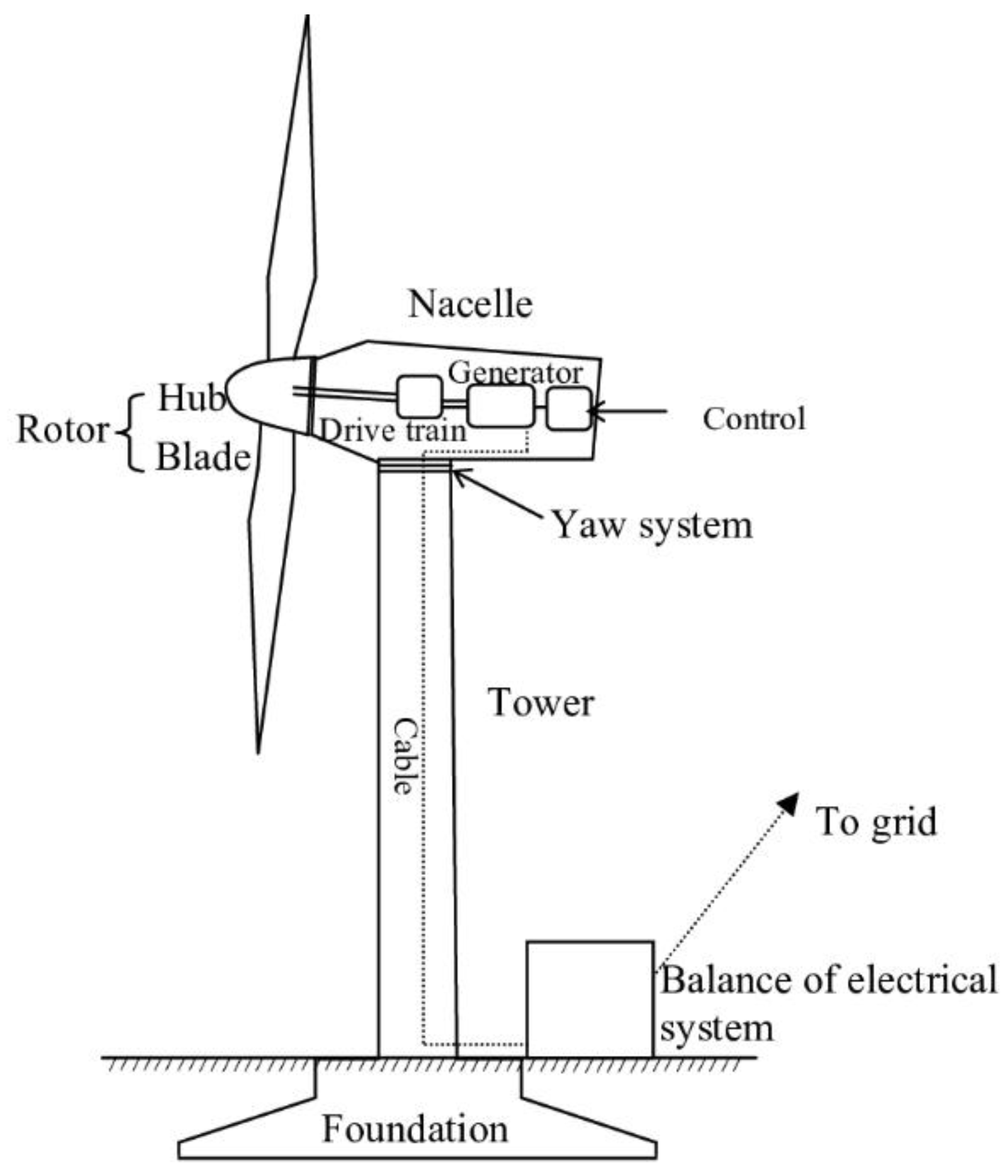
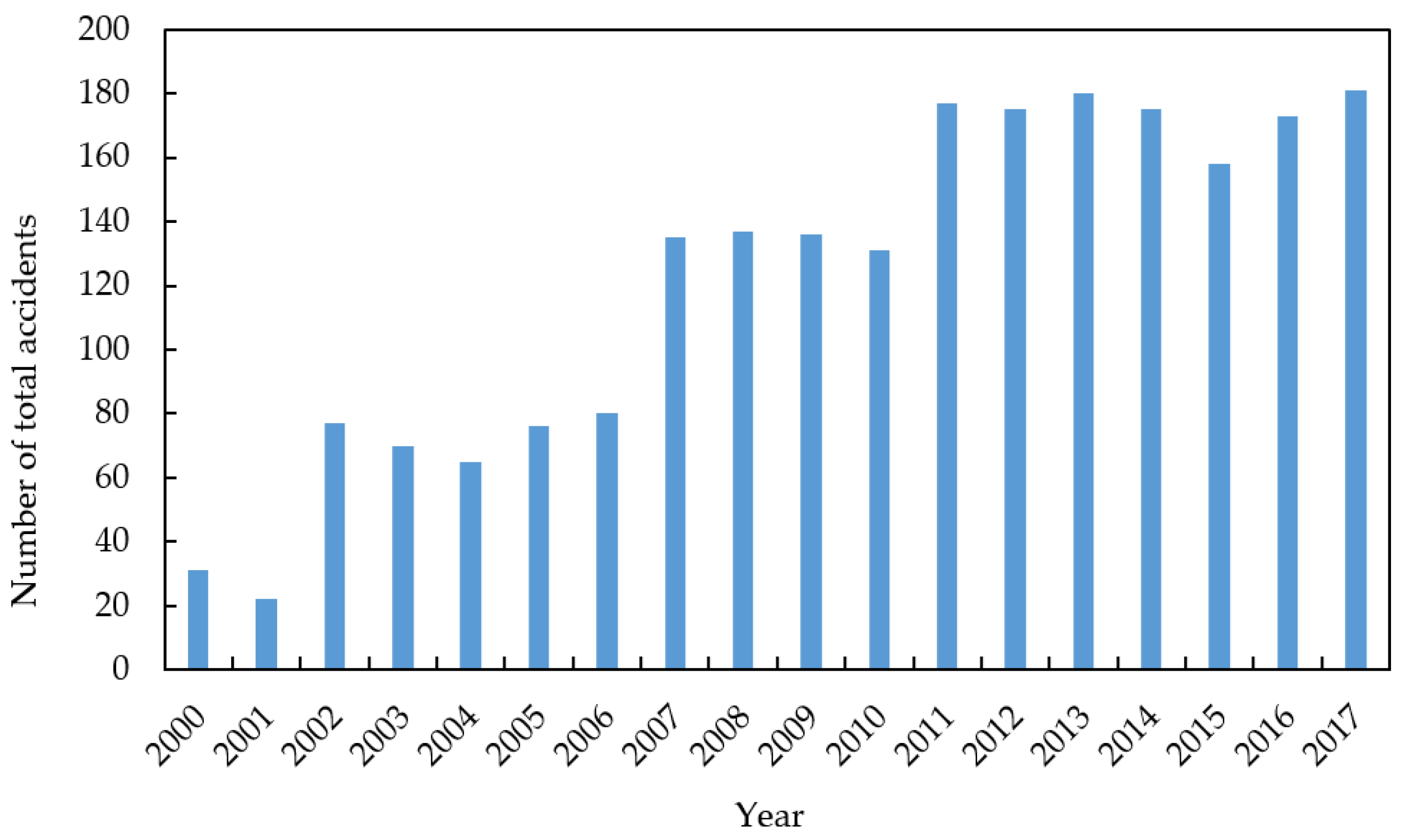
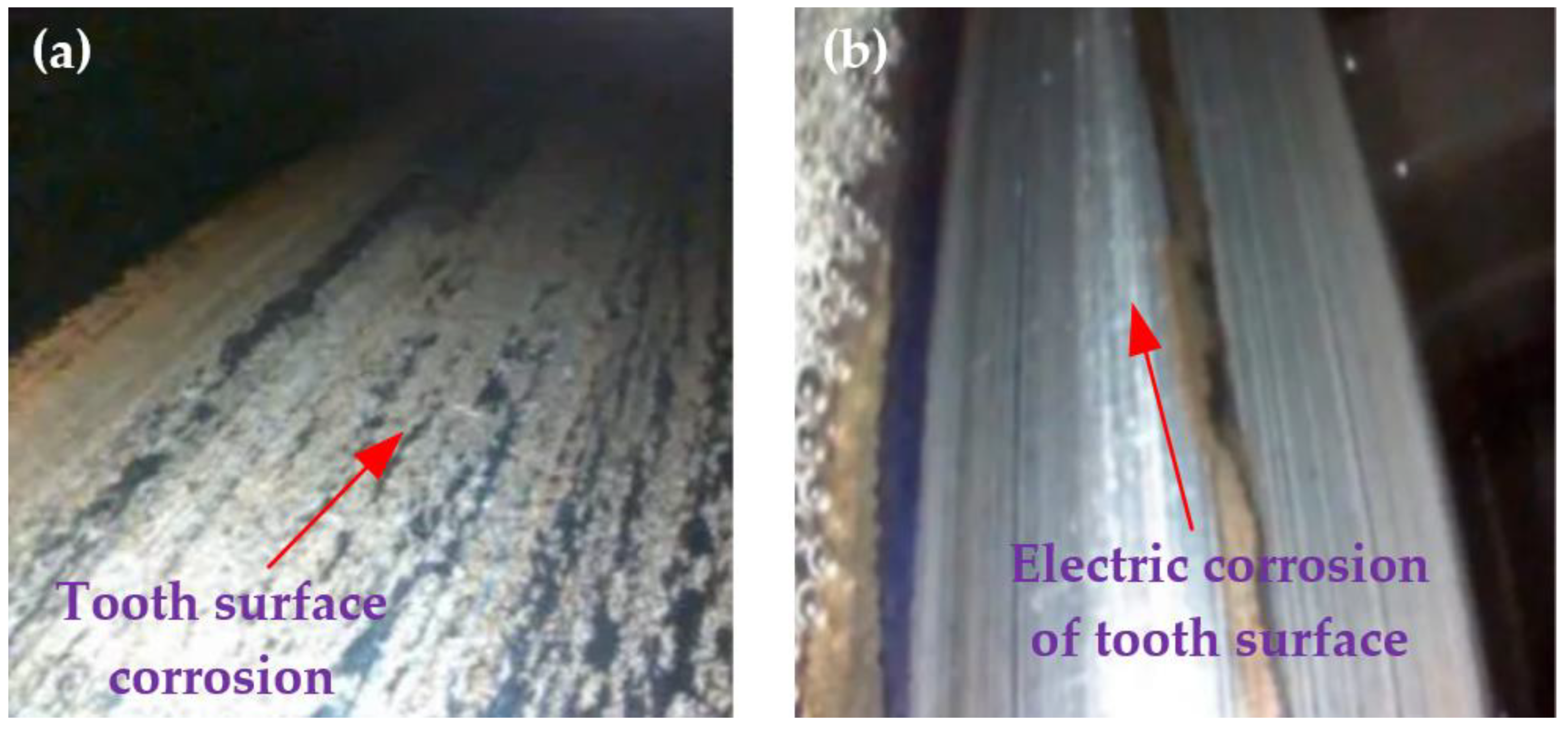
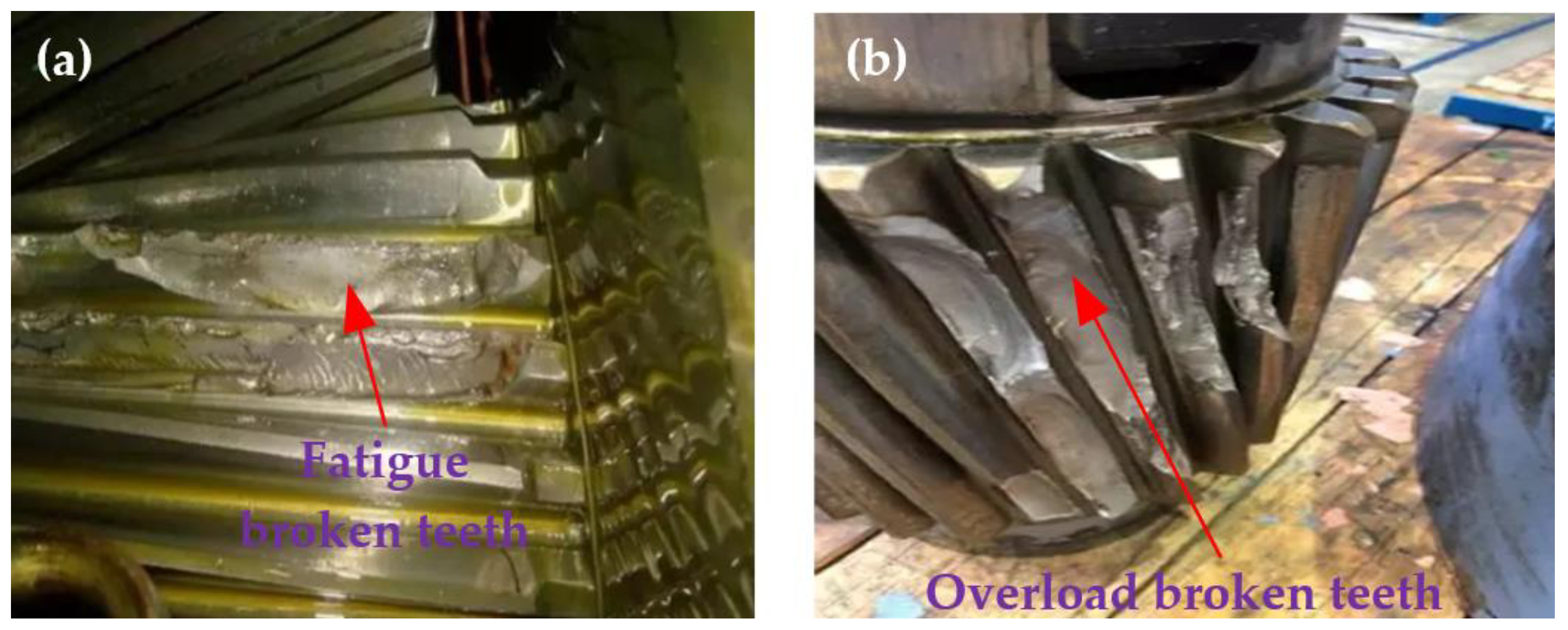

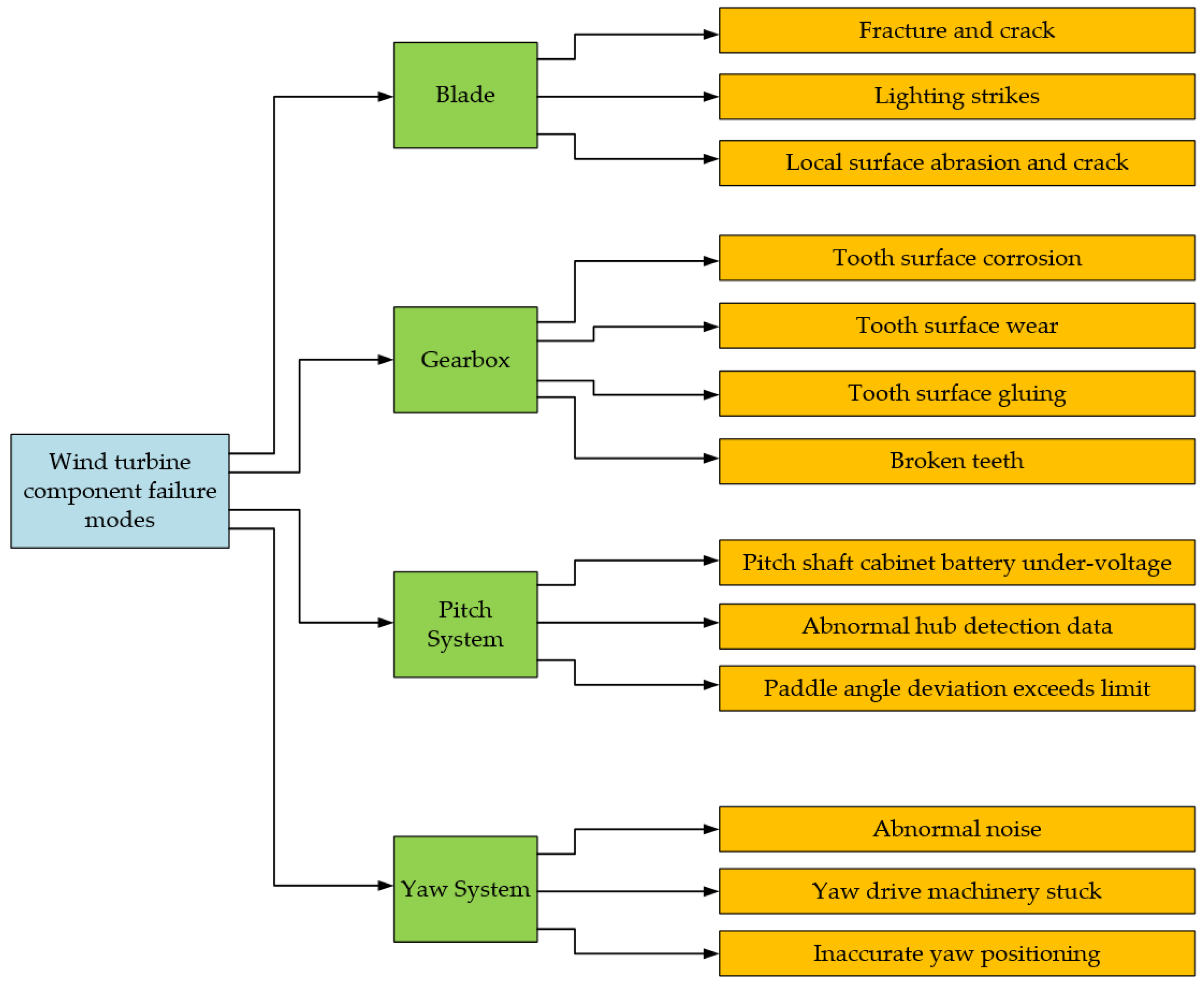
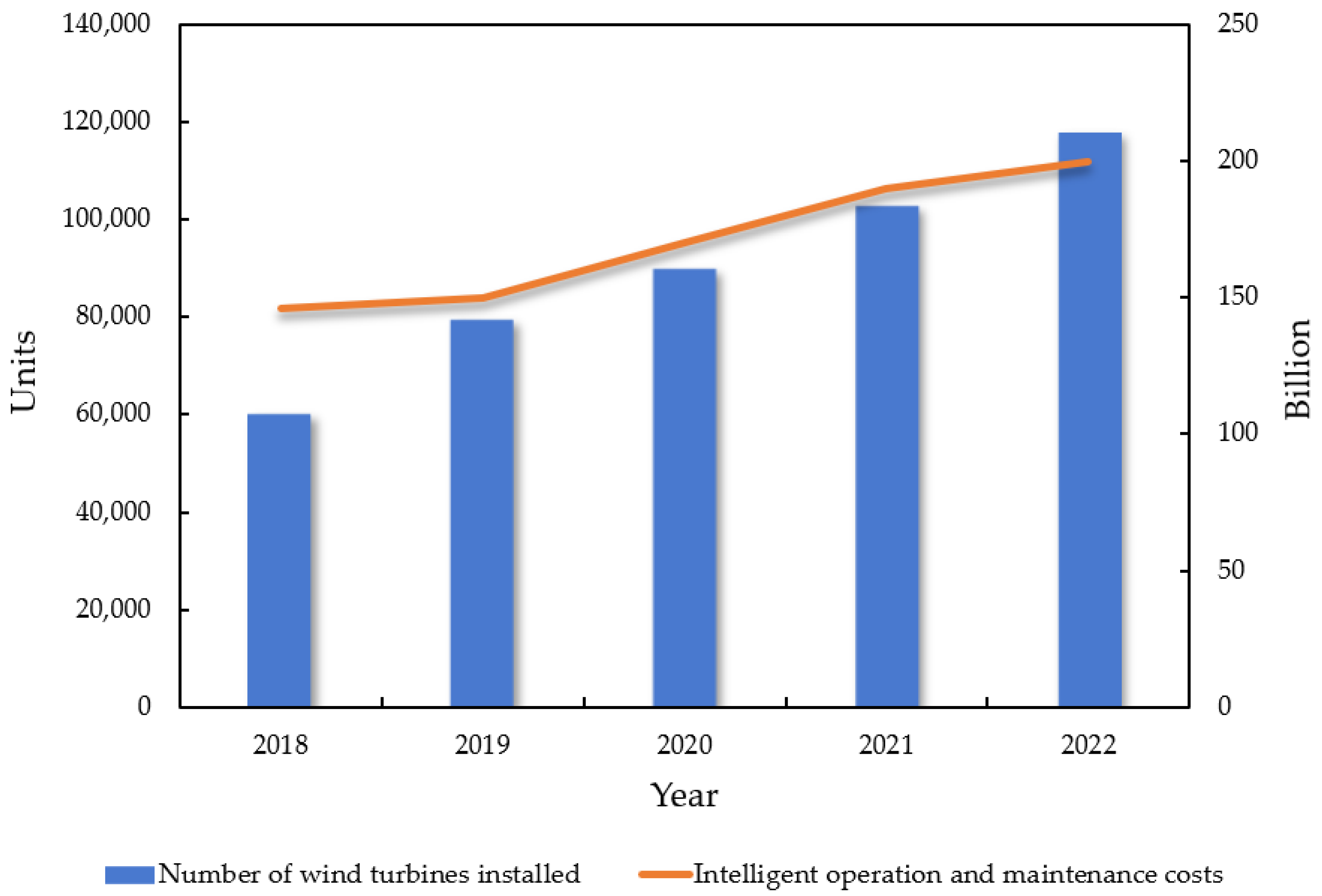

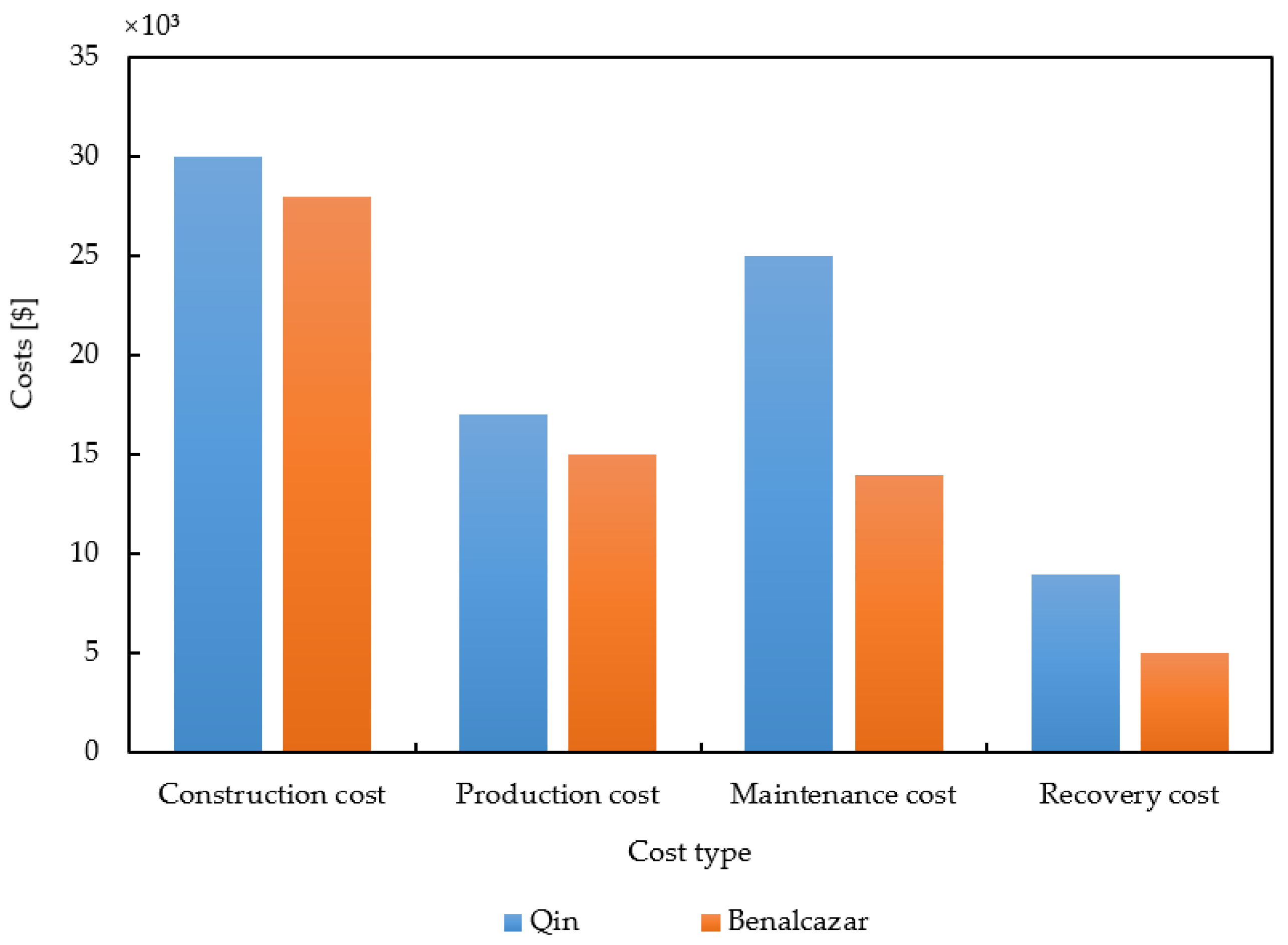



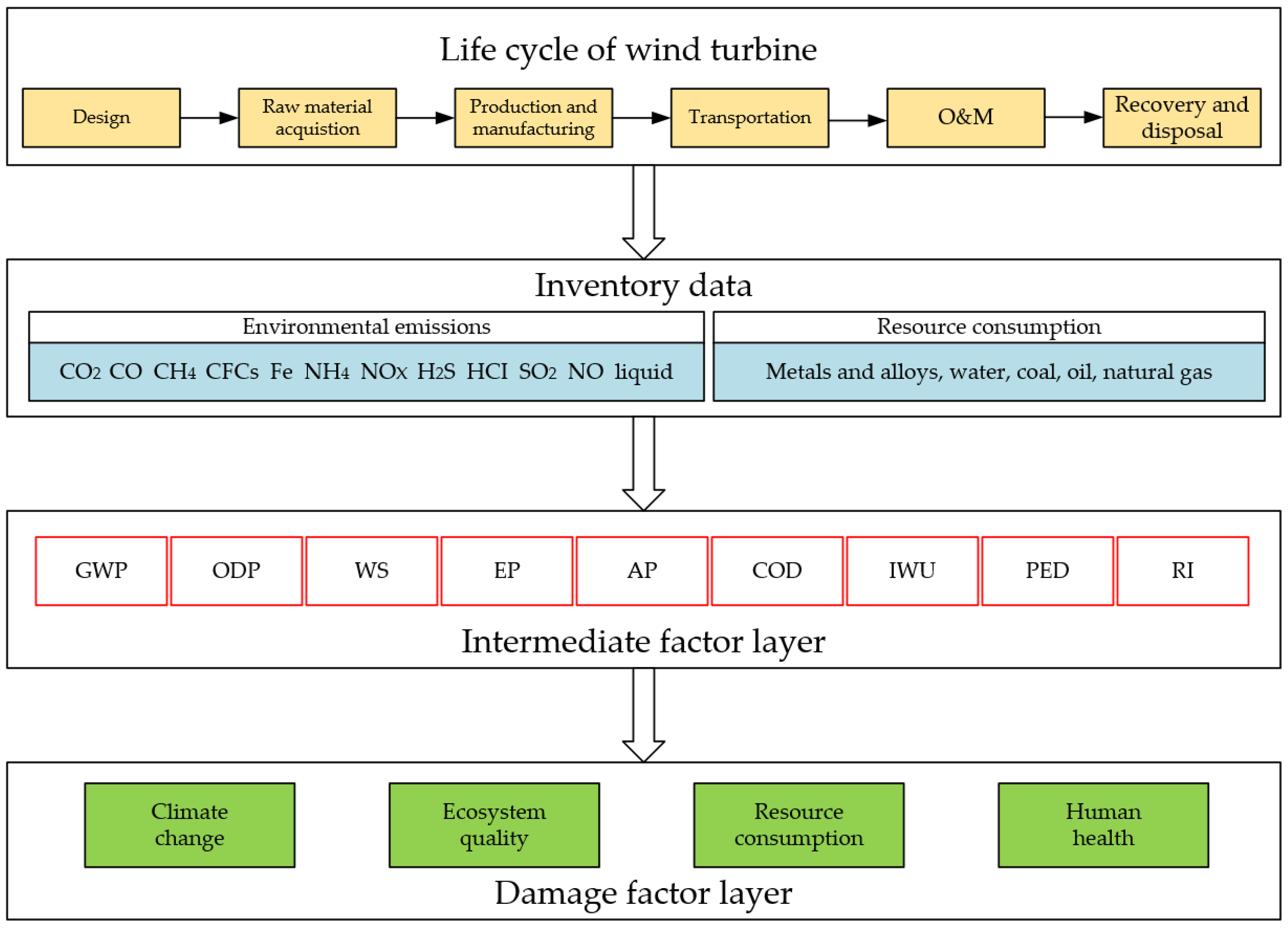
| Failure Mode of Each Component | Main Causes |
|---|---|
| Fracture and cracking | Design defects; poor quality; change in process; lack of production experience |
| Lightning strikes | Cracks in components; fouled blade surface |
| Local surface abrasion and crack | Abrasion by wind, sand, and water vapor; extreme weather |
| Tooth surface corrosion | Excessive water content of lubricating oil; wet working environment |
| Tooth surface wear | Machining accuracy; material defect; short-term overload; inactivity for an extended period |
| Tooth surface gluing | High-speed or low-speed heavy load |
| Broken teeth | Fatigue; overload |
| Pitch shaft cabinet battery under voltage | Shaft cabinet battery under voltage; charging loop fault |
| Abnormal hub detection data | Communication failure |
| Paddle angle deviation exceeds limit | Rotational overrun |
| Abnormal noise | Deterioration of driving motor oil; transmission bearing damage; ring tooth broken; uneven ring clearance; lack of grease in yaw system; brake damping pressure exceeds limit |
| Yaw drive machinery stuck | Planetary gear train failure |
| Inaccurate yaw positioning | Brake failure of yaw motor |
| Cost Type | Cost Content |
|---|---|
| Hardware costs | The cost of hardware equipment required by wind power intelligent O&M software, such as servers and data storage devices [95] |
| Software costs | Copyright fee and usage fee for wind power intelligent O&M software [96] |
| Labor costs | Labor maintenance costs, including technical support, system updates, etc., as well as labor costs for maintaining wind power equipment [97] |
| Communication costs | Communication costs related to intelligent O&M [98] |
| Monitoring equipment costs | The cost of monitoring and testing equipment, such as sensors and measuring equipment [99] |
| Operating costs | Includes costs for manpower, materials, and funds required for daily operation management, supervision, maintenance, and troubleshooting; predictive maintenance and scheduled maintenance; coordination and organizational management [100] |
| Training costs | The cost of training personnel to use intelligent wind power O&M systems, including the cost of training facilities and labor costs [101] |
| Method | Raw Signals | Wavelet Coefficients | ||||
|---|---|---|---|---|---|---|
| CNN | WDCNN | CNN | WDCNN | ResNet | HA-ResNet | |
| Accuracy (%) | 87.13 ± 2.57 | 94.13 ± 1.39 | 95.43 ± 1.08 | 93.14 ± 0.61 | 96.50 ± 1.26 | 98.79 ± 0.34 |
| Signals of Leahy | Description | Signals of Marti-Puig | Description |
|---|---|---|---|
| az | Yaw system faults | Power | Generator output power |
| ba | Backup battery system faults | Wind speed | Average wind speed in 30 s |
| bk | Braking system faults | Rotor speed | Generator rotor speed |
| fc | Frequency Converter faults | Winding temperature | Generator winding temperature |
| gb | Gearbox faults | Drive-end bearing temperature | Generator drive-end bearing temperature |
| gn | Generator faults | Non-drive-end bearing temperature | Generator non-drive-end bearing temperature |
| mi | Miscellaneous | Nacelle temperature | Temperature inside the nacelle |
| pt | Pitch system faults | ||
| to | Tower faults |
| Method | MAE (MW) | MAPE (%) | RMSE (MW) | R2 | Reference |
|---|---|---|---|---|---|
| Persistence | 3.53 | 0.76 | 5.95 | 0.991 | Lledó. [189] |
| LSTM | 2.83 | 0.71 | 4.06 | 0.995 | Li. [190] |
| CNN-LSTM | 3.31 | 0.72 | 5.07 | 0.992 | Wu. [191] |
| AGRU | 2.12 | 0.46 | 3.71 | 0.996 | Niu. [192] |
| Bi-LSTM | 2.56 | 0.55 | 4.03 | 0.995 | Jaseena. [193] |
| CNN | 2.72 | 0.59 | 3.99 | 0.996 | Zhang. [194] |
| MLP | 2.23 | 0.48 | 3.72 | 0.996 | Khazaei. [195] |
| TCN | 2.26 | 0.49 | 3.72 | 0.996 | Li. [196] |
| SANN | 2.22 | 0.48 | 3.68 | 0.996 | Dai. [188] |
| Characteristic | Spar Case Study [201] | Semi-Sub Case Study [202] |
|---|---|---|
| Water depth (m) | 95–129 | 60–80 |
| Distance to shore (km) | 25 | 15 |
| Turbine rating (MW) | 6 | 9.5 |
| Number of turbines | 5 | 5 |
| Turbine model | SWT-6.0-120 | v164-9.5 |
| Substructure | Spar | Semi-submersible |
| Installation port | Peterhead | Dundee |
| O&M port | Peterhead | Aberdeen |
| Lifetime (years) | 25 | 25 |
Disclaimer/Publisher’s Note: The statements, opinions and data contained in all publications are solely those of the individual author(s) and contributor(s) and not of MDPI and/or the editor(s). MDPI and/or the editor(s) disclaim responsibility for any injury to people or property resulting from any ideas, methods, instructions or products referred to in the content. |
© 2023 by the authors. Licensee MDPI, Basel, Switzerland. This article is an open access article distributed under the terms and conditions of the Creative Commons Attribution (CC BY) license (https://creativecommons.org/licenses/by/4.0/).
Share and Cite
Peng, H.; Li, S.; Shangguan, L.; Fan, Y.; Zhang, H. Analysis of Wind Turbine Equipment Failure and Intelligent Operation and Maintenance Research. Sustainability 2023, 15, 8333. https://doi.org/10.3390/su15108333
Peng H, Li S, Shangguan L, Fan Y, Zhang H. Analysis of Wind Turbine Equipment Failure and Intelligent Operation and Maintenance Research. Sustainability. 2023; 15(10):8333. https://doi.org/10.3390/su15108333
Chicago/Turabian StylePeng, Han, Songyin Li, Linjian Shangguan, Yisa Fan, and Hai Zhang. 2023. "Analysis of Wind Turbine Equipment Failure and Intelligent Operation and Maintenance Research" Sustainability 15, no. 10: 8333. https://doi.org/10.3390/su15108333
APA StylePeng, H., Li, S., Shangguan, L., Fan, Y., & Zhang, H. (2023). Analysis of Wind Turbine Equipment Failure and Intelligent Operation and Maintenance Research. Sustainability, 15(10), 8333. https://doi.org/10.3390/su15108333










